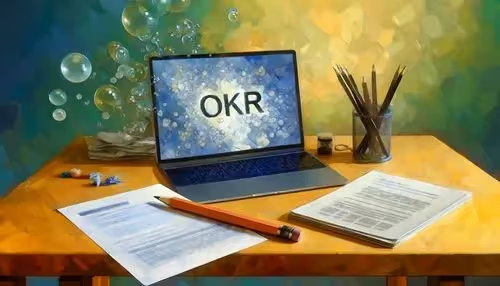
OKRs Explained: Full Guide and Tips for Setting Team Goals
From their intriguing origins and progression through organizations as large as Google, OKRs have been a go-to management framework for successful teams worldwide. Learn everything OKR in this article, and take your team to the next level with practical OKR application.
Every company should want to aim towards complete transparency, better prioritization, and generally a more effective strategy for executing tasks. If you agree with me, you should naturally find yourself in a position of supporting the idea of setting some new, ambitious, shiny OKRs. That is because these three results have been proven to be the most common motivations behind implementing OKRs. An abbreviation for 'objectives and key results', OKRs have become a vital part of many successful teams since the concept was brought about by John Doerr, who coined the term in a mainstream fashion, as a way of interconnecting key team objectives and the key results that were needing to be kept track of in order to measure development and movement towards hitting these objectives.
What are OKRs?
So we know the long version and the abbreviation, as well as their origin, but what exactly is an OKR? A strategic framework for teams to set goals and measure performance, the OKR methodology really revolves around establishing some ambitious yet achievable (in your eyes) goals, or objectives, and then attaching the relevant measurable outcomes, or key results to them, so that you and your team can evaluate your progress and success along the way.
As I say, Doerr was behind the popularization of the OKR, but the term was originally coined and developed by Andrew Grove, who introduced the approach to Intel in the 70s. Interestingly, OKRs were not popularized by word-of-mouth, but instead by shared experiences, which advocates for their utility perfectly. Doerr was a salesperson working for Intel in 1975, where he happened to attend a course that Grove was taking on his (at the time) 'Intel Management by Objectives' framework. This later became the OKR as we know it, but Doerr was inspired by this management method, and took it with him into his later life and career, where he would introduce and let the OKR permeate through organizations such as Kleiner Perkins and Google.
For many, the OKR framework is so powerful because it bridges the gap between aspiration and reality. By being ambitious within your capabilities, you can foster an energy of determination, which inspired teams to translate these visionary ideas into something more tangible in terms of achievement. These achievements come in all shapes and sizes, ranging from the Champions League Trophy to an increase in product user experience.
Defining OKRs
When we define our OKRs, we have to make sure that we think strategically about our objectives. It's all well and good having aspirational goals, but if they don't culminate in achieving something great overall, we might just be wasting our energy. Therefore, pay close attention to how your objectives align with the broad vision of your company or organization. For example, scoring 10 goals in a season might normally be seen as a great objective and achievement, but if your team only cares about winning the record for the least goals conceded, would your energy have been better spent defending?
Obviously this is dependent, and it is rare that an achievement being hit will end up being a negative, but on the whole, each objective should encapsulate a key area of improvement or growth that is important to you and your colleagues, and it should be complemented by clear and quantifiable key results that set you up well to track progress. If you do not do this it is hard to label your framework an OKR, as the pairing of visionary goals with practicable, and most importantly, measurable outcomes is what sets OKRs apart from other run-of-the-mill goal-setting frameworks.
How do You Write Great OKRs?
As you might have noticed by now, writing and defining OKRs is not a simple process to be hastily carried out in a half hour team meeting. Crafting effective OKRs is both an art and a science. Challenging but realistic, optimistic but not delusional, your objectives should push your team to their boundaries in terms of achievement, and should help inject some belief into the team by showing and telling them what is possible and attainable.
Key results, however, should be less up in the air and more quantifiable. You don't want to let things drag on, and should be willing to accept underachievement if the converse to that would slow progress even more. Therefore, they also have to be time-bound, so that there is a concrete way to measure success against time and energy expended to get to that stage of the objective. To give an example, using my earlier example of increasing product user experience, you would want to set the framework up in a way that creates an objective of: "Achieve a 30% increase in user satisfaction scores by Q3". This would be measured by things like user feedback and surveys and is therefore a measurable objective set up in a way that avoids vagueness.
How to Implement OKRs
We want to implement our OKRs well after taking so much care to create them. Following this series of steps will stand you in good stead:
- Training and Education: Don't go into this blind. Begin by educating your team about the OKR framework and how you see it being beneficial. Make sure everyone understands its purpose and how it is going to align with the company’s overall strategy and objectives.
- Developing Hierarchical OKRs: As I said, we want to reach a stage where our OKRs culminate to bring mass success organization-wide. Therefore, set OKRs at different organizational levels – from company-wide blanket goals that focus more on the overall direction to team-specific and even individual objectives that align with broader aims and represent a good use of time.
- Consistent Tracking and Adaptation: This is critical! Use regular check-ins to assess progress and keep the communication going to understand pitfalls and areas that need unblocking. I have a great software suggestion coming up that will help you ace this stage of OKRs, so sit tight. Overall, be prepared to adjust OKRs as necessary based on observations and feedback, as you may stumble upon unforeseen challenges.
- Leveraging Technology: Implement software into your OKR framework to facilitate tracking, collaboration, and transparency within your organization. Let's jump into my top recommendation for OKR tracking tech now.
Make your
meetings matter
Loved and trusted by 100,000+ users:
- Automatically Record and Transcribe Meetings
- Extremely Accurate Notes, Summaries, and Action Items powered by AI
- Works with Zoom, Google Meet, and Microsoft Teams
- Save time and follow-up with quick async videos
Simply connect your work Google or Microsoft Calendar to get started.
OKR Implementation and Tracking Technology
An effective OKR framework should involve lots of communication and the ability to keep track of everything that needs to be monitored. However, you also want your framework to be efficient and allow everyone involved to get on with their own priorities. Therefore, you should avoid a scenario where your OKR setup only functions with video calls and long conversations every few days. For this, we have found that the best approach is to communicate asynchronously.
So, now you are probably thinking about email updates or Slack messages. But, the issue I have found with these communication forms is the lack of context. By instead using a tool like Bubbles for asynchronous OKR progress updates, you are able to record a video of your screen with audio and video, allowing you to walk through your work and share any big progress updates or success stories.
Bubbles will also allow you to record that initial kick-off video meeting, where you define and set your OKRs, through the free-to-use AI Notetaker. This will allow you to keep a clear log of what was discussed, and for managers, you will also have a record for purposes of accountability.
Bubbles allows you to respond async with comments, either to the initial meeting notetaker, where you might want to get clarification on the OKRs themselves, or on each update where necessary, to either congratulate or give motivational feedback depending on how your teammates are getting on with their tasks.
Company-wide, Team-specific, and Personal OKR Examples
Having mentioned these OKR examples earlier, I thought it would be useful to give you an idea of how these could look in action.
Company-wide OKRs
Company-wide goals are crucial to generating an efficient organizational culture. You just have to look at a quote from Aaron Levie, who is CEO and founder of Box, who claimed that "at any given time, some significant percentage of people are working on the wrong things. The challenge is knowing which ones”. We want to eradicate pointless work through effective OKRs, even if it is accidental, and by setting goals that everyone can work towards, we keep things aligned. An example can come from Zume, and is as follows:
Objective: Delight customers.
However, under the objective we have the key results, such as an order rating of 4.6/5, or higher. Clear and quantifiable, the Zume employees will know what service usually gets awarded with these scores, and can therefore replicate over and over.
Team-specific OKRs
Equally important, but more so in a way of culmination, where we see the objectives of successful sub-teams joining together to nail the overall company-wide objective.
For example, with the Zume pizza example, the kitchen team might have their own objective of:
Objective: Ensure dough is kept fresh. To quantify this, Zume would have a survey system with a specific question regarding dough freshness, taste and quality.
Personal OKRs
For personal development within a sub-team and overall organization, this represents the lowest scale of OKR, but still one to be attentive to. An example, for an individual developer would be:
Objective: "Enhance coding skills by completing two advanced courses this quarter."
The Benefit of OKRs
The adoption of OKRs offers several benefits:
Clarity and Focus
We have covered this extensively, and you should now know exactly how OKRs can help teams and individuals concentrate on their key priorities and therefore thrive in a focused work environment.
Alignment and Collaboration
Again, OKRs ensure that there is no wasted effort. All efforts are aligned with the company’s goals with an effective OKR framework, and everyone knows where they stand, which helps us be better at teamwork and collaboration.
Enhanced Transparency and Accountability
Especially if you use Bubbles within your OKR framework, you will get a clear set of objectives and key results that holds everyone accountable and means that all communication is open.
Incorporating OKRs into Organizational Culture
A common mistake with OKRs is assuming that they will be adopted by your team straight away. We have to make an effort when it comes to ingraining our OKRs into the organization's culture, or else they won't be effective! Think bigger, and beyond them simply being a tool for goal setting. OKRs instead should be seen as a framework that drives ongoing employee engagement, performance management, and personal development. If you stress this when you explain the company goals, you have a higher chance of your defined goals being taken seriously. Your OKRs should be seen as a fundamental part of the company, and especially the company's journey and approach towards achieving success.
So, we have reached the end, and you are well on your way to becoming an OKR expert. However, your team may not be, and you should remember that. Make sure to explain the benefits of the OKR framework thoroughly to them, so that your carefully curated OKRs get the attention they deserve. Again, try doing this through Bubbles if you want to start your OKR journey as you mean to go on, with efficiency and effectiveness at the core!
Collaborate better with your team
Get your point across using screen, video, and audio messages. Bubbles is free, and offers unlimited recordings with a click of a button.
.avif)
Collaborate better with your team
Get your point across using screen, video, and audio messages. Bubbles is free, and offers unlimited recordings with a click of a button.
.avif)













.avif)